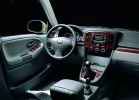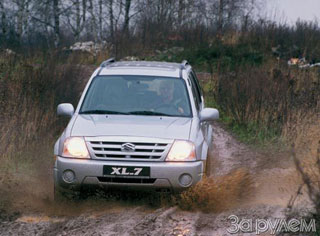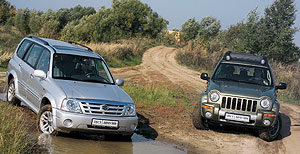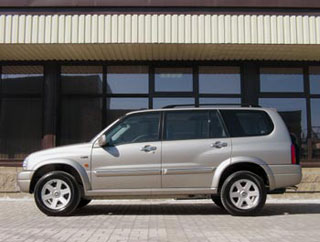Suzuki Grand Vitara XL7 2004 test drive - 2006 SUV
Updated flagship Suzuki
The Japanese Suzuki, known around the world with its low -profile and compact SUVs, very original approached the process of creating the flagship model, which the company was very missing to strengthen positions in the American market. She just took her bestseller, a five -door Grand Vitara SUV, and turned it into a model above. The wheelbase lengthened, the third row of seats appeared, and a new, more powerful motor was located under the hood - so it turned out to be Suzuki Grand Vitara XL -7. And now, a couple of years after the start of production, the company decided to finally abstract it from the rest of the versions of the Grand Vitara - by the 2004th model year the flagship was updated ...Last year, only a knowledgeable person could distinguish the new flagship XL-7 from the usual five-door Suzuki Grand Vitara. After all, the differences between the two versions were minimal: an elongated wheelbase and a slightly different shape of the rear side doors. Well, the nameplate, of course, are different. Otherwise, both inside and outside - XL -7 and just Grand Vitara were completely identical.
Since this year, everything will be different: the flagship 2.7-liter model is easy to distinguish from other modifications even from a distance of several hundred meters. After all, now the XL-7 has a completely original front! Instead of the usual rectangular headlights, a multilateral optics with a transparent glass is installed, and on a that significantly increased in the size of the false radiator grille there is a large stylized S. hood, front wings, moldings, wheel wheels - there are not so many changes, but they are all designed for one thing - to highlight Suzuki Grand Vitara XL-7 among other, less powerful modifications. And then, before, as it was: the car is more expensive, more prestigious, the only one of the entire range equipped with a 2.7-liter 173-horsepower engine, recognized if you look at it on the side.
It is only a pity that in addition to the front of the body and the pattern of the wheeled discs, the designers did not change anything else. In other angles, the top version is still identical to other modifications. And in the back, if you do not pay attention to the nameplate XL-7, it is generally impossible to find out what is the version in front of you.
The same situation with the salon: in 2002, the entire family offered a new dashboard and a little changed the interior. On time, because if the external design of the Grand Vitara still looks quite fashionable, then inside the car was very much like its age. Just think, the car developed at the turn of the millennia had an archaic ventilation control system with sliders, which other manufacturers refused a long time ago! And the tidy itself was also not the height of perfection - a simple finish, a nondescript lighting, an archaic mechanical odometer. But after restyling, the interior of all the Grand Vitar changed: more expensive materials are used in the decoration, and the tidy with a pleasant blue backlight is used. A new three -spoke bagel also appeared. In addition, a small liquid crystal display was installed on the dashboard from below, which displayed various information - about the mileage, for example. And with this screen, the car greets the owner: when you turn on the ignition, the inscription Hello appears on the display..
What else distinguishes XL-7 from other versions? In addition to excellent appearance, the top version also has the most powerful motor in the range - 2.7 liters, six cylinders. He produced 173 hp to restyling, and now his power is increased by 10 hp. - So, the dynamics of acceleration has also improved. This was also facilitated by the installation of a new automatic checkpoint - instead of an archaic four -speed machine, a 5 -speed automatic transmission was installed. It is only a pity that the designers did not provide for the manual regime - now such an option is in fashion. And the suspension settings, unfortunately, have not changed: Grand Vitara XL-7, as well as before modernization, repeats in detail the profile of the road, shaking the driver and passengers with a small trembling about all the bumps. Moreover, if you rush through a broken primer at a speed of 100 km/h, you will not feel discomfort, but when moving in a calm rhythm, but in poor asphalt, then the car is almost constantly trembling.
As before, the flagship Grand Vitara is equipped with an all -wheel drive transmission without an interdose differential - the leading axis is the leading axis, and the front bridge is connected only to overcome obstacles. True, it can be connected right on the go, at a speed of up to 100 km/h, which is very useful when driving along a winter road.
I saw, for example, ahead of the unrequited section of the road - and in one movement, without reducing speed, turned on all -wheel drive. In this mode, the machine also behaves more stable, and braking by the engine is the most effective, because all four wheels will slow down the movement. However, at the time of turning on all -wheel drive, it is worth remembering that the 4x4 mode is recommended only on slippery coatings, where the wheels can slip relative to each other. After all, a transmission with a rigidly connected front bridge experiences huge loads at the moment when the car moves along the arc or turns. In these situations, the torque is distributed equally, in a ratio of 50/50, so when the rear wheels at the turn pass a lower distance than the front ones, they need to put this excess of torque somewhere. And if the car rides on ice or dirt, then one of the rear wheels is simply turning, dropping this excess energy, and it is more difficult to do it on the asphalt.
Of course, because you will pass a couple of kilometers on a straight road on all -wheel drive, the car will not become worse - the main thing is that this road is straight, without steep turns. But the manufacturer strongly recommends not to ride with the connected front axle constantly, from October to March, but to use all -wheel drive only in case of emergency - for example, when driving on the road. And so that even on the most terrible off -road, the machine always has a power supply, the designers equipped Grand Vitar with a lowering gear. Having moved the handout lever to position L, you sharply reduce the minimum speed - now in the first gear the car moves at the speed of the pedestrian, but the torque increases many times. This mode is intended for difficult traffic conditions, although it can be used in other cases - for example, for movement on loose sand. After all, if you go in high gear, then for each start it will be necessary to bastard and fuse the clutch. And in reduced gear it is enough just to let go of the clutch. In addition, the regime L is also convenient in that at the time of activation of the lowering row, the rear inter -cross differential is automatically blocked, which repeatedly increases the cross -country ability. Of course, 90% of off -road success is properly selected tires, but the help of a blocked rear differential in combination with a rigidly connected front axle is difficult to overestimate. If you use all this farm correctly, then stopping Suzuki Grand Vitara XL-7 will not be possible even with diagonal hanging.
But if you need a professional SUV or just a very high cross -country car, then it makes sense to pay attention to the usual Grand of Vitars, ideally - three -door, short -brown. Because due to the increased rear axle, the cross-country cross-country version is very limited-on a steep rise, the car can cling to the rear bumper. And the elongated wheelbase does not at all help improve patency, since any hill can become an insurmountable obstacle only because the machine will sit on the obstacle, thus hanging the wheels. But the XL-7 version was not created to participate in rally-raids, so the parameters of geometric patency for this version are not particularly important. She retained an all -wheel drive transmission, an enlarged road clearance and a strong chassis on a spar frame. And this is quite enough ...
Pavel Kozlovsky








